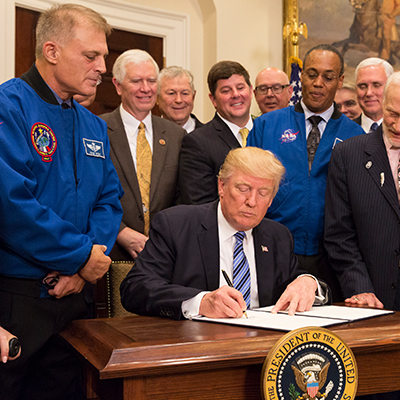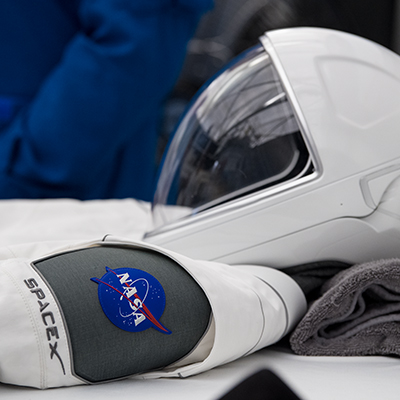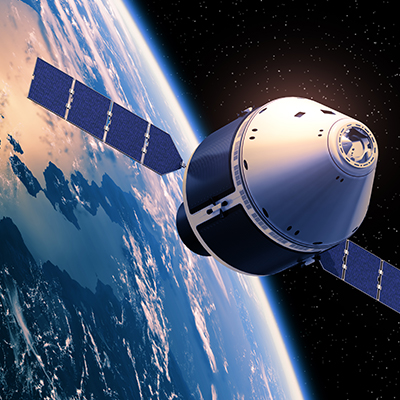Four Big Things to Watch in the Space Industry in 2020 (and a Quick Review of 2019)
At the beginning of 2019, Avascent identified some big things to watch in the space industry. So, what happened in 2019? And what should we keep an eye on in the space industry in 2020?
Looking Back at the Space Industry in
2019 …
1. China: Could it Keep its Space Industry Momentum Rolling?
 Assessment: Strong Showing with Some Notable Bumps
Assessment: Strong Showing with Some Notable Bumps
China achieved 32 successful launches in 2019, staged a test of its Mars lander, and resumed flight of the Long March 5 rocket. The Chinese government also supported a burgeoning domestic commercial space industry, which grew from 30 companies in 2018 to 150 in 2019.
Still, those private space endeavors are moving forward with mixed results: OneSpace and LandSpace both failed to reach orbit, then iSpace achieved the first commercial (private) Chinese orbital launch in July.
There were also signs of worry for the Chinese space sector in 2019, including a highly visible $250 million on-orbit failure (ChinaSat-18) and the inability to win a single major international GEOCOM order, despite global demand roughly doubling from 2018.
2. SpaceX: Mars Bound or Runaground?
Assessment: Lots of Cylinders Firing, but a Couple of Misfires
SpaceX had a busy 2019. It executed 13 successful launches—a good performance but far fewer than the 19 planned at the beginning of the year.
The new Starship progressed rapidly, but not on Elon Musk’s always-ambitious timeline, and Mk 1’s test anomaly (explosion) was a very visible example of SpaceX’s “fail fast and learn” approach.
The third launch of Starlink’s planned 12,000 satellites early this January made SpaceX the operator of the world’s largest satellite constellation (by count). If SpaceX reaches its planned launch cadence and attracts enough broadband internet subscribers, Starlink revenue is forecast to dwarf that of SpaceX’s launch business ($2+ billion).
However, uncertainty around the business model, user terminal maturity, and the lack of major distribution announcements leave much room for doubt.
On top of all of this, SpaceX made good progress on Commercial Crew for NASA (10 for 10 on multi-parachute tests) but also had a high-profile explosive test failure that destroyed the Crew Dragon. It will face increased rigorous testing and certification scrutiny, especially given Boeing’s own Starliner test anomaly last month.
3. ‘NewSpace’: A Year of Validation or Reckoning?
Assessment: The Strong and Well-Funded Survive, But the Shakeout Begins
For NewSpace companies, 2019 was a mixed bag. OneWeb started very strong, launching its first six satellites, securing $1.25 billion in financing, and opening its Florida production facility, but its main investor, SoftBank, had to write down $425 million of its investment and deal with a lawsuit from space heavyweight and former partner Intelsat.
The slew of flat-panel antenna startups failed to start production at scale, and small launch providers experienced both success and convulsions: Vector shut its doors, and Stratolaunch largely exited the launch market, even as Rocket Lab hit its ambitious advertised launch cadence, and Virgin progressed its testing and announced partnerships with the UK Space Agency.
The year 2019 also saw a slew of investor support for a variety of emerging companies with creative business models within the space industry (e.g., Loft Orbital raising $13 million, Spire $40 million and Orbital Insight $50 million), indicating that underlying interest—at least for companies with a clear path to revenue—remains high.
Overall, the NewSpace economy is maturing and “getting real,” with early successes (Hawkeye360), failures (Audacy), and missed deadlines (Blue Origin, SpaceX) across all segments of the value chain.
4. Citizen Astronauts: First Class or Business to Fly Space?
Assessment: Ready for Takeoff, But Still Stuck On the Tarmac
Private spaceflight saw some strong progress (and astronaut pins) in 2019—but not the promised commercial service.
Blue Origin ended its year of technical progress with another successful test but failed to meet Jeff Bezos’s goal of human flight by 2020.
Virgin Galactic raised $450 million from its IPO—a show of confidence in commercial human space flight as it readies SpaceShipTwo for its first commercial flight in 2020.
NASA announced it would buy seats on commercial missions to the ISS and funded commercialization initiatives—almost $1 billion in spend is planned through fiscal year 2024.
Signs are positive, but 2019 reinforced that in human spaceflight, “very soon” often means years away.
5. US Space Policy: The Right Stuff or Game of Thrones?
Assessment: Surprising Progress, But Lots More to Do
After a year of back-and-forth, resignations, firings, and retirements in the US military and space leadership, the US Space Command was re-established and the US Space Force officially created as the sixth branch of the military.
However, with neither the NRO, MDA, nor Army SMDC included in the Space Force, further organizational and con-ops realignment seems likely.
On the other hand, the Space Development Agency (SDA) still seems in search of an identify, receiving mixed congressional support and a 2020 budget that came in $25 million under its already modest $150 million request.
Meanwhile the Office of Space Commerce was elevated to a Bureau within the Department of Commerce and was entrusted with overseeing space situational awareness data (now deemed space domain awareness)—but it now must secure the budget and a team to execute its new mandate.
… and Four Big Things to Watch in the Space Industry in 2020
1. Will Big Policy Changes Bring Unintended Consequences?
All systems go for Space Force?

- As mentioned, the Space Force successfully stood up and now has a transition process moving 200 people within 90 days and up to 15,000 over the next five years.
- The SDA is slated to begin work on a multi-layer smallsat constellation, beginning with a transport layer. Watch for Space Force to encounter transition hiccups and slowdowns as well as complaints that its current structure complicates, rather than simplifies, the space acquisition landscape.
- Will nascent Space Force changes be reversed by a new Congress and Administration after November’s election? Will mixed congressional support and parallel acquisition programs drive SDA into an existential crisis?
Brexit: Should space stay, or should it go?
- The Tories’ sweeping victory and new, 162-seat majority in parliament all but guarantee the UK will leave the European Union. The UK’s participation in Galileo and a host of other space programs hang in the balance.
- Will the UK have squandered a billion pounds and need to develop a new UK GNSS capability when it leaves? Will UK MILSPACE sharing and co-development agreements (e.g., selling excess Skynet capacity) encounter new hurdles?
- Conversely, the UK Space Agency has re-emphasized its commitment to ESA, and ESA’s director-general Jan Woerner has expressed his hope that the UKSA remains as well. Will ESA defy Brexit and keep the UK in the fold?
More static for the C-Band Alliance?
- In 2019, the satellite operators that comprise the C-Band Alliance lost their campaign to hold a private auction (sale) of C-Band spectrum worth tens of billions of dollars to terrestrial 5G operators.
- An FCC announcement instantly wiped out 50 percent of the operators’ collective market valuation. Will the alliance be able to salvage a large compensation package to transfer its C-Band customers to make room for 5G?
- Or, lacking a cash windfall and facing capacity oversupply and new competitors, will GEO satellite operators be forced to consolidate and down-size?
2. The Space Industry Supply Chain: Integrate, Separate, or Consolidate?
More vertical integration, or a move to specialization?

- Growing space industry demands for rapid development, modular, high-volume production, and cost savings may drive more companies to consolidate supply chains.
- As new satellite operators and launch providers begin revenue-generating operations, will they follow the path of early-market entrants and move up (or down) the value chain hoping to find new cost advantages (e.g., OneWeb, SpaceX, and early-innovator Viasat)?
- Or will new entrants bet on the benefits of specialization and focus on one area (e.g., iDirect/Newtec)?
Will new space manufacturers displace longstanding providers?
- Will 2020 see big successes for companies specializing in innovative production techniques (e.g., the additive manufacturing of Relativity and low-cost smallsats from Blue Canyon)?
- Or will legacy providers adapt their production practices enough to stave off disruptors (e.g., Aerojet Rocketdyne and Maxar’s SSL)?
Is new space consolidation coming? And how fast?
- Seemingly each week brings another space start-up; Space Angels counted more than 500 space companies receiving investment in the 2010s, and the count of aspirational launch providers stubbornly remains well above 100.
- Will underlying demand justify the sudden influx of players, or will 2020 (finally) bring a combination of large-scale consolidation (e.g., Terra Bella and Planet) and market exits (e.g., LeoSat and Audacy)?
3. Satellites: Go Big, Go Small, or Go Home?
A different kind of small?

- After years of anticipation and a few false starts, small GEO satellites finally arrived at scale.
- With the promise of lower capex and greater flexibility to operators, smallsats accounted for nearly half the market in 2019.
- Three traditional manufacturers and two new space providers announced new small GEO bus lines (e.g., Boeing’s 702 Small Power).
- Will these investments continue to bear fruit in 2020? Or will the appealing operational scale economies of larger—but more costly—VHTS satellites, such as ViaSat 3, win out?
Meet me in the middle?
- Both traditional operators and NewSpace players alike have replaced some very large seven-ton GEO birds and very small cubesats with mid-sized (100-1,000 kilograms) satellites.
- “Proliferated LEO” smallsats, for instance, have largely moved from a cubesat experimental heritage toward commercial application (Starlink and OneWeb) and US national security programs such as Blackjack and HBTSS.
- Will mid-sized satellites become the Goldilocks “just right” solution for most space applications?
“Or go home?”
- Despite new investments, constellation deployments and manufacturing innovation, satellite demand could very well crash back to earth.
- A combination of more big names entering the industry (whether publicly, like Amazon Kuiper, or more secretively like Apple’s in-house satellite connectivity team) and signs of trepidation from more seasoned players (e.g., Maxar’s lowered production capacity, Telesat’s LEO slowdown), suggest a business reckoning is coming soon.
- Will new operators find the customers and business model to change the game? Or will 2020 see a capacity bubble burst?
4. Changing Risk Tolerance As ‘NewSpace’ Matures?
Will private investors recalculate?

- Private capital drove the space industry in 2019, and large and risk-tolerant investment houses (e.g., SoftBank) are still committed to, albeit more wary about, major space endeavors.
- Private investment in space reached $6 billion in 2019, per Space Angels, a 73 percent jump from 2018. But that’s not necessarily good news for new space startups.
- Space investment looks to be shifting toward later funding stages as established start-ups mature and need additional capital.
- Will private investment continue to flow to space in 2020? And will new start-ups get their share?
Changing public market confidence?
- While private capital has flowed into NewSpace, public markets have been a different story.
- Virgin Galactic’s IPO was the only space public offering in in 2019, and even many value-creating space companies underperformed the market.
- The S&P was up approximately 30 percent in 2019, while companies across the space value chain had much more mixed results: Maxar (+11%), Inmarsat (+27%, largely due to its take-private sale) and ViaSat (+ 17%) gained but underperformed, while Intelsat (-68%), Speedcast (-70%), and SES (-30%) investors suffered badly.
- Will 2020 bring new public investor confidence in space? Or will investors look elsewhere?
Space insurance: How much risk is too much?
- Despite the space industry’s many technological leaps (launch reusability, satellite flexibility, on-orbit repair), space manufacturers still appear to be struggling with one of the most critical elements of spaceflight—reliability.
- Recent losses have echoed across the industry. Launch problems (e.g., FalconEye-1’s $415 million loss) and on-orbit failures (e.g., WorldView-4’s $183 million, ChinaSat-18’s $250 million) have insurers re- examining what was once a market with seemingly better-understood risks.
- With premiums competed down to all-time lows in 2019—and payouts at an all-time high—some big insurers are re-evaluating the market itself.
- Swiss Re’s abruptly exited in July, and others are rethinking their exposures.
- Will exits continue in 2020? How will changing premiums impact broader space economics?



